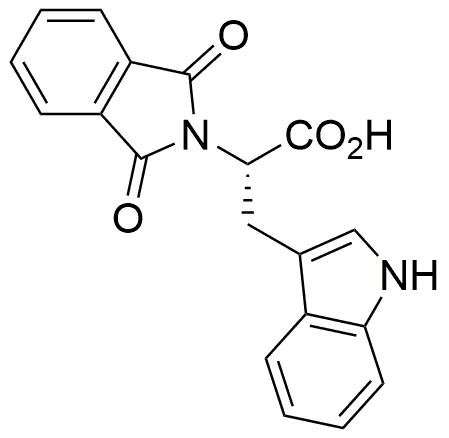N-Phthalyl-L-tryptophan is widely utilized in research focused on:
- Pharmaceutical Development: This compound is used in the synthesis of novel drugs, particularly those targeting neurological disorders, due to its ability to modulate serotonin pathways.
- Biochemical Research: It serves as a valuable tool in studying protein interactions and enzyme activities, helping researchers understand complex biological processes.
- Food Industry: N-Phthalyl-L-tryptophan can be explored as a food additive to enhance flavor profiles or as a precursor in the synthesis of natural flavor compounds.
- Cosmetic Formulations: Its properties make it suitable for incorporation into skincare products, where it can help improve skin hydration and overall appearance.
- Material Science: The compound is investigated for its potential use in developing biodegradable plastics, contributing to more sustainable materials in various applications.
General Information
Properties
Safety and Regulations
Applications
N-Phthalyl-L-tryptophan is widely utilized in research focused on:
- Pharmaceutical Development: This compound is used in the synthesis of novel drugs, particularly those targeting neurological disorders, due to its ability to modulate serotonin pathways.
- Biochemical Research: It serves as a valuable tool in studying protein interactions and enzyme activities, helping researchers understand complex biological processes.
- Food Industry: N-Phthalyl-L-tryptophan can be explored as a food additive to enhance flavor profiles or as a precursor in the synthesis of natural flavor compounds.
- Cosmetic Formulations: Its properties make it suitable for incorporation into skincare products, where it can help improve skin hydration and overall appearance.
- Material Science: The compound is investigated for its potential use in developing biodegradable plastics, contributing to more sustainable materials in various applications.
Documents
Safety Data Sheets (SDS)
The SDS provides comprehensive safety information on handling, storage, and disposal of the product.
Product Specification (PS)
The PS provides a comprehensive breakdown of the product’s properties, including chemical composition, physical state, purity, and storage requirements. It also details acceptable quality ranges and the product's intended applications.
Certificates of Analysis (COA)
Search for Certificates of Analysis (COA) by entering the products Lot Number. Lot and Batch Numbers can be found on a product’s label following the words ‘Lot’ or ‘Batch’.
*Catalog Number
*Lot Number
Certificates Of Origin (COO)
This COO confirms the country where the product was manufactured, and also details the materials and components used in it and whether it is derived from natural, synthetic, or other specific sources. This certificate may be required for customs, trade, and regulatory compliance.
*Catalog Number
*Lot Number
Safety Data Sheets (SDS)
The SDS provides comprehensive safety information on handling, storage, and disposal of the product.
DownloadProduct Specification (PS)
The PS provides a comprehensive breakdown of the product’s properties, including chemical composition, physical state, purity, and storage requirements. It also details acceptable quality ranges and the product's intended applications.
DownloadCertificates of Analysis (COA)
Search for Certificates of Analysis (COA) by entering the products Lot Number. Lot and Batch Numbers can be found on a product’s label following the words ‘Lot’ or ‘Batch’.
*Catalog Number
*Lot Number
Certificates Of Origin (COO)
This COO confirms the country where the product was manufactured, and also details the materials and components used in it and whether it is derived from natural, synthetic, or other specific sources. This certificate may be required for customs, trade, and regulatory compliance.


